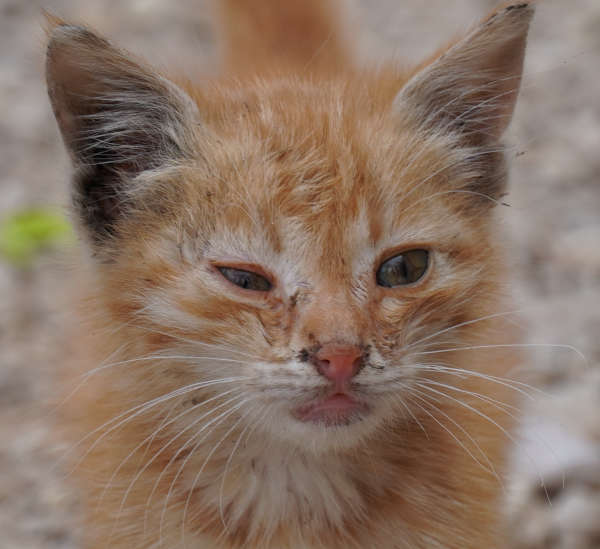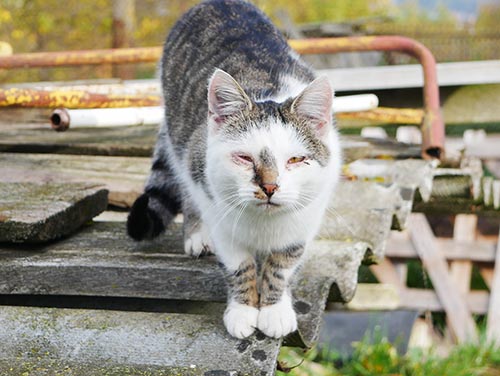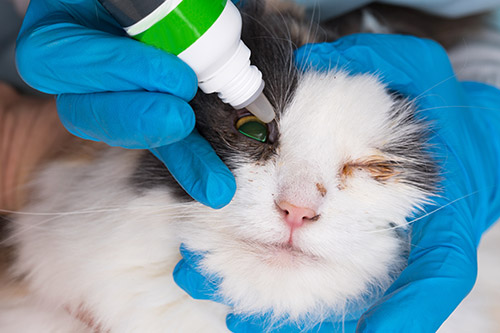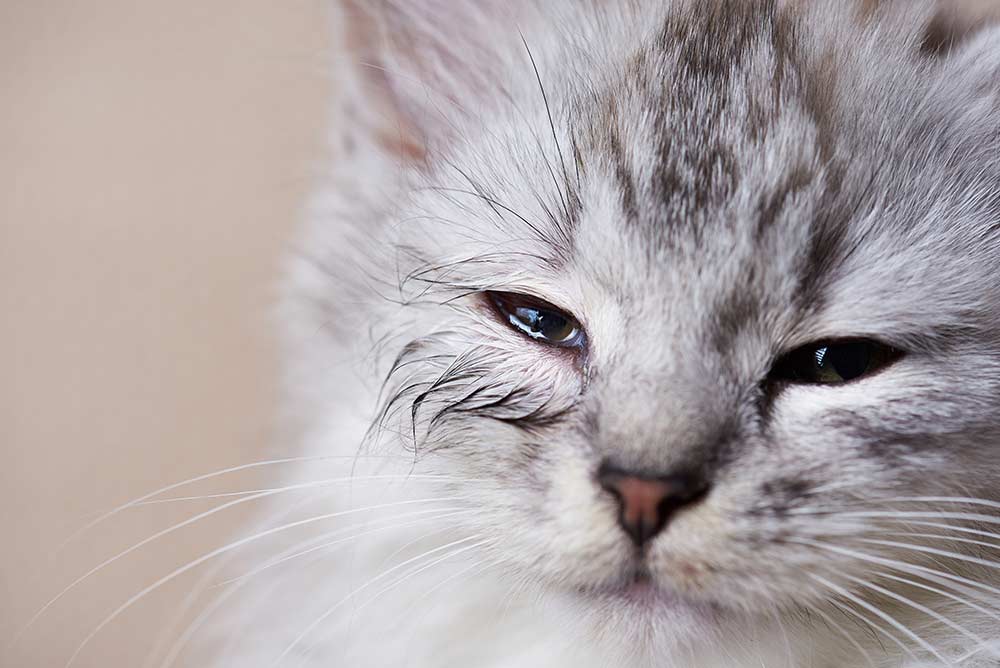Cats can be susceptible to yellow discharge from their eyes and it’s important for the owners to be aware of this. As a Veterinary Ophthalmologist, I have handled numerous cats with yellow eye discharges. In this article, I will provide an overview of the conditions that can cause yellow eye discharge in cats along with their associated symptoms in order to help you identify and treat them quickly.
A change in color of the mucous thread to yellow or green is a reliable indicator of the presence of inflammatory cells and mandates a careful clinical examination as ocular surface disease is also frequently present.
Your cat’s eyes symptoms
When your feline friend has an issue with their eyes, some signs you may observe include:
- Yellow ocular discharge or weeping
- Pain/blinking/keeping one or both eye(s) closed
- Third eyelid protruding
- Eye redness or swelling
- Eye cloudiness
- Coughing, sneezing, nasal discharge or any other symptoms
7 causes of yellow ocular discharge in cats
Common causes include:
- Cat Flu
- Conjunctivitis
- Allergies
- Eye ulcers
- Eyelid infection
- Blocked tear ducts
- Eye injuries, ocular foreign body or trauma
1. Cat Flu
Cats, like humans, can be affected by a flu-like illness that presents with symptoms such as fever, sneezing, watery eyes, and runny nose.
Cat flu is a contagious disease and once infected, cats may retain the virus for life. This can lead to them having long-lasting symptoms that persist throughout their lifetime.
There is currently no definitive cure for the symptoms associated with a particular illness, however medical treatment can help reduce the severity and speed up recovery. Kitten are usually more severely affected by infections than adults because their immune system is weaker and not as capable of combating them.
Symptoms of cat flu
- Weepy eyes and yellow discharge
- Snotty nose
- Sneezing
- Low energy
- Painful eyes (flu can cause eye ulcers)
- Reduced appetite or no appetite at all
- Oral ulcers
- Fever
- Sore throat (you might notice difficulty swallowing or gagging)
- Coughing
Causes of cat flu
Causes include:
- Herpes virus
- Calicivirus
- Chlamydophila bacteria
- Bordetella
A cat that has an acute upper respiratory infection will be infective to other cats during the incubation period and for up to three weeks after developing symptoms. A cat that is a carrier of an upper respiratory virus may stay infective to other cats perpetually.
Cats that are unvaccinated, young cats or those who have chronic underlying conditions, are more susceptible and may develop a serious illness. Adequately vaccinated adult cats may develop only a mild case of illness, which might resolve without treatment.
Treatment of flu in cats
Your veterinarian may prescribe eye medication if your cat has a purulent eye discharge. Although viral infections do not respond to antibacterial drugs, broad-spectrum antibacterial drugs may be prescribed to prevent secondary bacterial infections from complicating the disease, particularly in kittens. Primary bacterial upper respiratory infections caused by Bordetella or Chlamydophila will be treated with specific antibiotics that are effective against these diseases.
Home care for cat flu
Once your cat has been treated by your vet, there are some things you can do at home to help your pet recover:
- Try to keep your cat’s life as stress-free as possible because stress can make illness worse.
- To encourage your pet to eat, try adding a little bit of warm food with strong scent like sardines, anchovies, or tuna to their meals, provided they do not have any allergies to these items.
When to contact your vet
If you notice any indications that your cat may have the flu, it is essential to contact your vet without delay. Prompt action can prevent the condition from deteriorating rapidly.

2. Conjunctivitis
Conjunctivitis, the most common of all feline eye disorders, is an inflammation of the thin mucous membrane (conjunctiva) that lines the inner surface of a cat’s eyelids and coats the outer surface of the eyeball. Many cats will experience at least a mild episode of the condition at some point in their lives.
The clinical signs of the condition can be evident in either one or both eyes and will typically be observed as well in the third eyelid—the membrane positioned in the inner corner of a cat’s eye, between the lower eyelid and the eyeball.
The signs include:
- Pain/blinking/keeping one or both eye(s) closed.
- Presence of a discharge that, depending on the cause of the conjunctivitis, can be either colorless and watery or yellow-colored.
- The conjunctiva and third eyelid become swollen and red.
Treatment:
Veterinary treatment is usually all that is needed to manage mild conjunctivitis as it should not last long. Speak to your vet to discuss the right action plan. If your vet suspects that an underlying condition is causing your cat’s conjunctivitis, they may need to run more tests or examinations to determine the cause.
It is likely that your vet will recommend the following treatments:
– Anti-inflammatory treatment
– Topical or/ and systemic antibiotic for bacterial infection
– Topical or/ and systemic antiviral medication for viral infection
– Lubricating drops
When to contact your vet
Contact your vet as soon as you notice a problem with your cat’s eyes – eyes are precious and the problem could get worse if they aren’t treated quickly.
If your cat has had a weepy eyes for a while, book an appointment with your vet to have them checked. Even if the problem has been going on for a while, there is a chance that your pet could have a treatable condition.

Cat with conjunctivitis and yellow eye discharge.
3. Allergies
One of the most common medical conditions affecting cats is allergy. Allergy occurs when the cat’s immune system overreacts or is hypersensitive to foreign substances called allergens.
The signs include:
- Sneezing
- Weeping and ocular (eye) yellow discharge
- Sometimes nasal discharge (clear, yellow, brown, red, or grey)
- Coughing
- Wheezing
- Itching skin – in one part of the body or the whole body
- Vomiting
- Flatulence
- Diarrhea
There are 4 common types of allergies in cats:
- Insect (fleas)
- Food allergy
- Atopic dermatitis (house dust, pollen, and molds)
- Contact
Treatment of allergies
If your cat displays symptoms of allergies, it may be necessary to manage the condition. There are three primary methods for managing feline allergies:
- Trying to avoid the triggers;
- Treatment to manage itchy skin and watery eyes;
- Immunotherapy/vaccination treatment.
When to contact your vet
In case your furry friend is experiencing itchy skin, watery eyes, yellow discharge from their eyes or any other symptoms mentioned earlier, it’s crucial to seek help from your veterinarian. Itchy skin and watery eyes in cats usually don’t subside on their own and can lead to discomfort and misery for your pet, regardless of the underlying cause.
When a cat experiences anaphylaxis, it means that their body is having a severe and potentially life-threatening allergic reaction to something they have ingested or been exposed to.
Common symptoms in a cat experiencing anaphylaxis include:
- Collapse
- Difficulties breathing
- Hives
- Facial swelling
- Itchiness
- Swelling
- Trembling
- Wheezing
- Cold extremities
- Pale gums
- Diarrhea
- Vomiting
It is crucial to seek immediate medical attention for your cat if you suspect they are experiencing anaphylaxis.

Cat with a yellow eye discharge.
4. Eye ulcers
Corneal ulcers, which are injuries sustained to the cornea of the eye, must be treated in order to resolve. If left unattended, they can result in severe consequences such as blindness.
Corneal ulcers have a wide variety of potential causes, including:
- Viral or bacterial infection. According to Thomas Kern, DVM, associate professor of ophthalmology at Cornell University’s College of Veterinary Medicine, the most frequent cause is recurrent infection with the feline herpesvirus (FHV).
- Cat scratches.
- Ingrown eyelashes.
- Foreign body.
- Being exposed to caustic chemicals.
The clinical signs of corneal ulceration include:
- Inflammation surrounding the cornea
- Ocular discharge (yellow, clear, brown, grey, or red discharge), or weeping
- Clouding of the cornea
- Photophobia
- Squinting, rubbing the eyes, behaving as if having vision problems
When to contact your vet
If pet owners notice something wrong with their cat’s eye, it is important to take prompt action and consult a vet. The vet will conduct a thorough examination and then determine the best course of treatment.

A corneal ulcer in a cat with yellow eye discharge.
5. Eyelid infection
Blepharitis means inflammation of the eyelid.
The clinical signs of eyelid infections include:
- Scratching or rubbing its face or eyelids leading to secondary trauma to the
surrounding tissues.
- Possible discharge from the eye that may be yellow, red, clear, brown, mucoid, or purulent.
- Inflammation has been present for a significant amount of time, there may also
be loss of pigment or hair.
- Skin covering the eyelids may have dry crusts or flakes on its surface and small
papules or pustules (pimples) may develop on the surface.
- One or more meibomian glands (glands that help lubricate the eyes) along the
margin of the eyelid may become swollen.
- In more severe cases, the inflammation may spread and include conjunctivitis
(inflammation of the conjunctiva) or keratitis (inflammation of the cornea).
The cause of blepharitis
- Entropion.
- Allergies.
- Infections (bacteria, fungal, viral, parasites, or protozoal).
Cats that have been infected with feline herpes virus-1 (FHV-1) may develop chronic blepharitis as a secondary problem. Bacterial infections may cause localized abscesses of glands in the eyelids or generalized infections of the eyelids. In some cases, infection with Staphylococcus bacteria (staph) may lead to an allergic reaction, called Staphylococcus hypersensitivity.
- Tumors.
- Trauma.
- Occasionally other inflammatory disorders.
Persian, Himalayan, and Burmese cats are more likely to develop blepharitis due to their facial conformation (flattened faces, and prominent folds of skin between the nose and eyes). These breeds of cats may have lagophthalmos (bulging eyes) and they are predisposed to lower eyelid entropion.
When to contact your vet
If you notice any issues with your cat’s eye, it is crucial to act quickly and seek advice from a veterinarian. The vet will carefully examine the eye and recommend the most appropriate treatment plan based on their findings.

A cat with eyelid infection and yellow eye discharge.
6. Blocked tear ducts cause tears to spill down the face
The lacrimal duct is part of the nasolacrimal system. The nasolacrimal system consists of a series of narrow tubes that allow tears to drain from the eye.
This system allows excess tears to drain from the eye to the nose and mouth. While not as common in cats as in dogs, this nasolacrimal duct can become obstructed or blocked. Obstruction may result in tears overflowing and running out of the eye. This overflow of tears can lead to moisture and tear staining below the eye.
The cause of lacrimal duct obstruction:
- Shape and size of the cat’s head and muzzle.
- Hereditary defect in the formation of the nasolacrimal duct. This defect results in the lack of an opening where the nasolacrimal duct meets the conjunctiva (pink tissue surrounding the eye). This is referred to as imperforate puncta.
- Inflammation or infection, within the eye or lacrimal duct, may lead to swelling that blocks the duct.
- Tumors that develop along the duct.
- Foreign material lodged within the lacrimal duct.
Treatment of lacrimal duct obstruction
Many cases of nasolacrimal duct obstruction are caused by inflammation. In these cases, anti-inflammatory medications and antibiotics may alleviate the obstruction. In other cases, surgery may be required for treatment.
When to contact your vet
If you notice any issues with your cat’s eye, it’s crucial to act quickly and seek advice from a veterinarian. The vet will carefully examine the eye and suggest an appropriate treatment plan based on their evaluation. It’s important to address any problems promptly to ensure the well-being of your cat.

A cat with yellow eye discharge.
7. Eye injuries, ocular foreign body or trauma
If your furry friend is displaying signs like avoiding bright lights, keeping its eye closed or squinting, it’s likely that they have suffered an eye injury. It can be extremely severe and cause blindness if left untreated. So don’t wait and take your cat to the vet as soon as you noticed the symptoms for prompt diagnosis and proper treatment.
If your cat has sustained an eye injury, the symptoms will usually appear quickly and worsen with time. It is important to look out for these tell-tale signs that could indicate an eye injury:
- Pain/blinking/keeping eye closed
- Yellow ocular discharge or weeping
- Third eyelid protruding
- Eye redness or swelling
- Eye cloudiness
- Blood in the eye
- A change in the size/shape of the pupil
Treatment:
The amount of treatment required for any sort of eye injury in cats depends on its severity and which part of the eye is affected.
Penetrating Injuries:
If the injury has not perforated the eye, your vet may recommend anti-inflammatory and antibiotic medications or eye drops may also be prescribed to reduce eye inflammation. Antibiotic ointments are commonly used in the treatment of corneal ulcers.
Perforating Injuries
Surgery is the go-to option for any incident involving a perforation – such as a tear in the cornea, or when an object is embedded in the eye. Even full-thickness wounds can be treated this way. In case there is a foreign object, surgery may also be done to remove it from the eye.
When you should contact your vet
If your cat is exhibiting any signs of ocular discomfort, such as blinking excessively or keeping an eye shut, not eating, being lethargic, or hiding away, they may be in extreme pain and it is important to contact your veterinarian ASAP if you notice any of those issues. Some of these ailments may be more serious than others, so it is best to get professional opinion on this matter.
If left untreated, the problem could become much worse. You know your cat best – contact your vet if you’re concerned.

A cat with an eye injury and yellow eye discharge.
References
- Slatter’s Fundamentals of Veterinary Ophthalmology; Fifth Edition; David J. Maggs; Paul E. Mille; Ron Ofri; Lacrimal System; Chapter 9; Page 167

